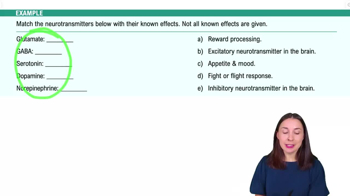Table of contents
- 1. Introduction to Psychology1h 43m
- 2. Psychology Research2h 20m
- 3. Biological Psychology2h 41m
- 4. Sensation and Perception28m
- 5. Consciousness and Sleep32m
- 6. Learning41m
- 7. Memory34m
- 8. Cognition37m
- 9. Emotion and Motivation35m
- 10. Developmental Psychology33m
- 11. Personality48m
- 12. Social Psychology41m
- 13. Stress and Health41m
- 14. Psychological Disorders44m
- 15. Treatment47m
3. Biological Psychology
Communication in the Nervous System
Struggling with Psychology?
Join thousands of students who trust us to help them ace their exams!Watch the first videoMultiple Choice
Which of the following examples would be most similar to a neuron?
A
A gun that fires when the trigger is pulled
B
Tree branches that grow after receiving nourishment from the sun and rain
C
A silicon chip in a computer that receives and transmits information between input and output devices as well as between other chips
D
A nozzle at the end of a hose from which water is squirted
 Verified step by step guidance
Verified step by step guidance1
Understand the function of a neuron: Neurons are specialized cells in the nervous system that transmit information through electrical and chemical signals.
Identify the key characteristics of neurons: Neurons receive information, process it, and then transmit it to other neurons or cells.
Analyze each example: Consider how each example functions in terms of receiving, processing, and transmitting information.
Compare the examples to the function of a neuron: A neuron is similar to a system that receives input, processes it, and sends output, much like a silicon chip in a computer.
Conclude which example best matches the function of a neuron: The silicon chip in a computer is most similar to a neuron because it receives and transmits information, akin to how neurons operate in the nervous system.

 1:20m
1:20mWatch next
Master Electrochemical Communication with a bite sized video explanation from Hannah Gordils
Start learningRelated Videos
Related Practice
































